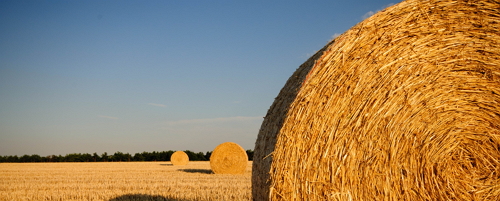Analysis of Straw

Background
Straw is a general term that can cover most solid plant residues from crops. It can include oilseed rape, rye, barley, wheat, oats, beans, and peas. In Ireland, the cereal straws are the most abundant. When wheat or barley is threshed, straw is a byproduct that is typically laid back on the field during the combining process. Some may be collected and used for bedding, feed supplement, or mushroom compost production. However, much is left to rot on the field.The yield of straw per unit mass of grain will vary according to the plant type and the local environment. However, the average yield of wheat straw is 1.3 to 1.4 kg per kg of grain.
Analysis of Straw at Celignis
Celignis Analytical can determine the following properties of Straw samples:
Sugars (Monosaccharides)
Sugar Alcohols and Uronic Acids
Lignin and Extractives
- Lignin (Klason)
- Lignin (Klason - Protein Corrected)
- Lignin (Acid Soluble)
- Acid Insoluble Residue
- Extractives (Ethanol-Soluble)
- Extractives (Water-Soluble)
- Extractives (Exhaustive - Water then Ethanol)
- Lignin S/G Ratio
- Extractives (Water-Insoluble, Ethanol Soluble)
- Protein Content of Acid Insoluble Residue
- Carbon Content of Acid Insoluble Residue
- Hydrogen Content of Acid Insoluble Residue
- Nitrogen Content of Acid Insoluble Residue
- Sulphur Content of Acid Insoluble Residue
Amino
Acids
Thermal Properties
- Moisture
- Ash
- Ash (Acid Insoluble)
- Carbon
- Hydrogen
- Nitrogen
- Sulphur
- Oxygen
- Volatile Matter
- Fixed Carbon
- Gross Calorific Value
- Net Calorific Value
- Chlorine
- Ash Shrinkage Starting Temperature (Oxidising)
- Ash Deformation Temperature (Oxidising)
- Ash Hemisphere Temperature (Oxidising)
- Ash Flow Temperature (Oxidising)
- Ash Shrinkage Starting Temperature (Reducing)
- Ash Deformation Temperature (Reducing)
- Ash Hemisphere Temperature (Reducing)
- Ash Flow Temperature (Reducing)
- Thernogram - Under Nitrogen
- Thermogram - Under Air
Major and Minor Elements
Cellulose Content of Straw
The chemical compositions of straws will be dependent on the relative proportions of the components of the plant (e.g. nodes, internodes etc.) and the chemical compositions of these components. The harvesting procedure is also important since it determines how well the different components are collected.The specific cultivar of the species may also be important as the relative proportions of leaves and internodes may differ between varieties and different cultivars may also lose differing quantities of leaves in the harvesting process, due to variations in the brittleness of leaves.
Celignis founder Daniel Hayes has extensive experience in the collection, preparation, and chemical/infrared analysis of straw samples. He has carried out research projects, funded by the Irish Environmental Protection Agency and the Irish Department of Agriculture, that involved the analysis of a variety of straw types.
Cellulose is the principal component in straw samples. The cellulose content can vary between different varieties of the same plant species. There is greater variability in cellulose content between straws from different plant species.
Click here to see the Celignis Analysis Packages that determine cellulose content.
Hemicellulose Content of Straw
Hemicellulose is the second most abundant constituent in straws, with xylose being the principal hemicellulos sugar, followed by arabinose. Galactose is present in concentrations that are typically around three times less than arabinose, whilst rhamnose and mannose are minor components.Click here to see the Celignis Analysis Packages that determine hemicellulose content.
Lignin Content of Straw
Lignin is the third most abundant polymer in most straws (after cellulose and hemicellulose). The lignin content can vary between different varieties of the same plant species. There is greater variability in lignin content between straws from different plant species.Click here to see the Celignis Analysis Packages that determine lignin content.
Starch Content of Straw
The starch contents of straws are typically quite low but can vary according to the maturity of the plant.Click here to see the Celignis Analysis Packages that determine starch content.
Uronic Acid Content of Straw
Uronic acids can be present as side chains attached to the main backbone of hemicelluloses in straws. They concentrations of uronic acids tends to be greatest in the nodes, lower in the internodes, and at intermediate levels in the leaves.Click here to read more about uronic acids and to see the Celignis Analysis Packages that determine uronic acid content.
Enzymatic Hydrolysis of Straw
We can undertake tests involving the enzymatic hydrolysis of Straw. In these experiments we can either use a commercial enzyme mix or you can supply your own enzymes.We also offer analysis packages that compare the enzymatic hydrolysis of a pre-treated sample with that of the native original material.
Click here to read more about enzymatic hydrolysis and to see the various analysis packages that we offer.
Ash Content of Straw
The ash content of agricultural straws is comparable to grassy energy crops but higher than most woody feedstocks.Click here to see the Celignis Analysis Packages that determine ash content.
Heating (Calorific) Value of Straw
Straws have good heating values, meaning that they are suitable for utilisation in boilers for the production of heat and/or electricity. However the effective heating value will depend greatly on the moisture content of the biomass.Click here to see the Celignis Analysis Packages that determine heating value.
Biomethane Potential (BMP) of Straw
Straw can be somewhat recalcitrant to degradation in anaerobic digestion processes due to the predominance of lignocellulosic material. However, it can be used as a co-feed with more labile feedstocks (e.g. manures). Alternatively, pre-treatment processes that reduce the recalcitrance of the lignocellulosic matrix can be employed.Click here to see the Celignis Analysis Packages that determine the biomethane potential (BMP) and here to read more about anaerobic digestion and the most important analytes for this process.
Bulk Density of Straw
At Celignis we can determine the bulk density of biomass samples, including Straw, according to ISO standard 17828 (2015). This method requires the biomass to be in an appropriate form (chips or powder) for density determination.Click here to see the Celignis Analysis Packages that determine bulk density.
Basic Density of Straw
At Celignis we can determine the basic density of some suitable biomass samples. The method requires the biomass to be in an appropriate form (chips) for density determination.Click here to see the Celignis Analysis Packages that determine basic density.
| Previous Feedstock | Next Feedstock |
Go Back to List of Feedstocks.
Energy
Crops
Agricultural Residues and Wastes
Industrial Residues and Wastes
Municipal
Wastes
Biorefinery
Products






